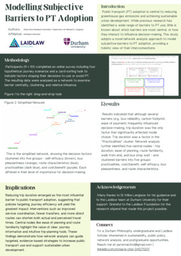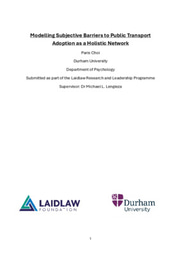Research Project Proposal: "Modelling subjective barriers to public-transport adoption as a complex network"
I was accepted as a Laidlaw Scholar in March 2025, following submission of the following research proposal. The research aims towards modelling barriers to public transport using network analysis. This research hopes to inform sustainable policymaking through insights from behavioural science, with some policy recommendations featured in my final report.
Research Proposal:
Modelling subjective barriers to public-transport adoption as a complex network
Supervised by: Professor Michael L. Lengieza, Department of Psychology, Durham University
INTRODUCTION AND BACKGROUND
Adoption of public transport is a critical environmental issue facing urban areas and towns within the UK. According to the definition provided by the European Standards Committee (2016, August 26), public transport is a publicly available business area known by everyone, having fixed times or frequencies and operating periods, having fixed routes and stops or/with predefined departure and destination points and having a specified fee. With the increased population of urban areas, the number of vehicles has increased dramatically, causing damaging effects on the environment and increasing traffic. The issues identified with the increase in vehicles and transportation demand include air pollution, noise, security, traffic congestion, delays and increased travel costs (2011, Awasthi, A., & Chauhan, S. S.). As a solution to this problem, the adoption of public transportation could help to mitigate the negative environmental effects.
However, there are barriers to the adoption of public transportation identified in the UK, including, as a sample, the lack of accessibility for disabled individuals, the increased cost of transport and cost of living, and delays in public transportation. The proposed project aims to better understand these factors, allowing councils to make informed changes to encourage public transport use.
RESEARCH QUESTIONS
To achieve the project aim of gaining an understanding of subjective barriers to public transport adoption in a UK context, the following research questions will be addressed:
- What does the network of subjective barriers to public transport adoption look like?
- What are the central barriers?
- Which are the most influential?
- Are there routine clusters of barriers that tend to appear together?
Following from this research, I also propose a couple of additional research questions with a focus on policy implementation:
- How can national bodies respond to address the barriers identified from our research to increase public transport adoption?
- What could be the potential costs and benefits of policy implementation?
METHODOLOGY
This project will adopt an innovative network approach (Lengieza, 2025) as outlined in the research proposal. This will first involve delivering an online survey to gauge participants’ subjective perceptions of the barriers to using public transportation. The survey will be released either in collaboration with Durham University or Durham County Council. Following this, the data will be modelled using the principles of social network analysis to gain a holistic understanding of the barriers to public transportation use.
This will involve a literature review of the main factors concerning barriers to public transportation adoption, use of public transportation and established intervention methods. The primary focus will be UK-based research and, where appropriate, data from County Durham, but comparable research elsewhere will be considered to identify larger trends. This literature review will inform which barriers are to be analysed and included in the survey.
Where appropriate, there will also be discussions with local bodies, including Durham County Council, to better understand public transport use and behaviour not covered by the literature. This will ensure that the research produced is most relevant to national bodies in Durham.
The modelling stage will make use of the data collected from the surveys. Using the network approach, the data will be visualised such that it is transparent what the factors affecting public transport adoption are, and which factors are the most prevalent among participants. This is the most suitable model for this project as it allows for clear visualisation of the data without a need for statistics/numbers, making the output accessible.
Analysis of the modelling results will be used in the final research report to conclude which are the most substantial barriers to public transportation adoption, the network of central barriers, the central barriers, and any clusters of barriers. The report will also be used to suggest how these findings could help inform policy, including a proposal for the council to encourage the adoption of public transportation locally.
SCHEDULE
Before the 6-week window: Gain ethical approval.
Weeks 1-2: Literature review and selection of barriers to be included in the survey.
Weeks 3-4: Data collection and modelling.
Week 5: Final analysis of modelling results.
Week 6: Report write-up.
Feel free to reach out if you are interested in this area of research or would like to know the results (I will likely publish my completed report and poster later down the line!).


Please sign in
If you are a registered user on Laidlaw Scholars Network, please sign in
Such an important project! As a former Laidlaw Scholar from India, I’ve seen how public transport can completely transform access, opportunity, and sustainability when it truly works for people.
I love that you’re focusing on subjective barriers, understanding the human experience behind the data is what makes policy recommendations meaningful and actionable. Excited to see what your network analysis uncovers and how it can inform better systems here in the UK!
Thanks so much, Asha! I'll publish the full report sometime next month, so keep an eye out